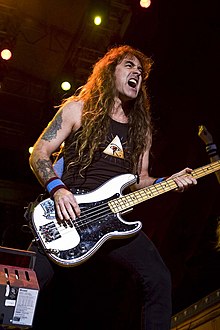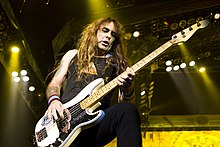
Iron Maiden are an English heavy metal band formed in Leyton, East London, in 1975 by bassist and primary songwriter Steve Harris. Although fluid in the early years of the band, the line-up for most of the band's history has consisted of Harris, lead vocalist Bruce Dickinson, drummer Nicko McBrain, and guitarists Dave Murray, Adrian Smith and Janick Gers. As pioneers of the new wave of British heavy metal movement, Iron Maiden released a series of UK and US Platinum and Gold albums, including 1980's debut album, 1981's Killers, and 1982's The Number of the Beast – its first album with Bruce Dickinson, who in 1981 replaced Paul Di'Anno as lead singer. The addition of Dickinson was a turning point in their career, establishing them as one of heavy metal's most important bands. The Number of the Beast is among the most popular heavy metal albums of all time, having sold almost 20 million copies worldwide.

The Number of the Beast is the third studio album by English heavy metal band Iron Maiden. It was released on 22 March 1982 in the United Kingdom by EMI Records and in the United States by Harvest and Capitol Records. The album was their first to feature vocalist Bruce Dickinson and their last with drummer Clive Burr.

Maiden England is a live video by the band Iron Maiden during their Seventh Son of a Seventh Son world tour, which was dubbed Seventh Tour of a Seventh Tour.

Paul Bruce Dickinson is an English singer. He is the lead vocalist of the heavy metal band Iron Maiden. Dickinson has performed in the band across two stints, from 1981 to 1993 and from 1999 to the present day. He is known for his wide-ranging operatic vocal style and energetic stage presence.

Janick Robert Gers is an English musician who is best known as one of the three guitarists in heavy metal band Iron Maiden. He initially joined to replace Adrian Smith, but remained in the band even after Smith rejoined. Gers was previously a member of Gillan and co-founder of the band White Spirit in 1975.

The Soundhouse Tapes is the debut EP by Iron Maiden, and features the first recordings by the band. Released on 9 November 1979, it features three songs taken from the demo tape recorded at Spaceward Studios on 30 and 31 December 1978. The three tracks appear in a rougher form than they would on the band's eponymous debut studio album and subsequent singles, as they were all recorded in one session.

Iron Maiden is the debut studio album by English heavy metal band Iron Maiden, released on 14 April 1980 by EMI Records in the UK and Harvest and Capitol Records in the US. The North American version included the song "Sanctuary", released in the UK as a non-album single. In 1998, along with the rest of the band's pre-1995 releases, Iron Maiden was remastered with "Sanctuary" added in all territories. However, 2014 vinyl reissues, 2015 digital releases and 2018 CD reissues use the original track listing across the globe. It is the band's only album to feature guitarist Dennis Stratton.

Seventh Son of a Seventh Son is the seventh studio album by English heavy metal band Iron Maiden. It was released on 11 April 1988 in the United Kingdom by EMI Records and in the United States by Capitol Records. Like The Number of the Beast (1982) and later Fear of the Dark (1992), The Final Frontier (2010), and The Book of Souls (2015), the album debuted at number one on the UK Albums Chart. The lead single "Can I Play with Madness" was also a commercial success, peaking at No. 3 in the UK Singles Chart.

Fear of the Dark is the ninth studio album by English heavy metal band Iron Maiden. Released on 11 May 1992, it was their third studio release to top the UK Albums Chart, and the last to feature Bruce Dickinson as the group's lead vocalist until his return in 1999.

Adrian Frederick Smith is an English guitarist and singer best known as a member of heavy metal band Iron Maiden, for whom he also writes songs and performs backing vocals both live and in the studio.

No Prayer for the Dying is the eighth studio album by English heavy metal band Iron Maiden. It is their first album to feature Janick Gers on guitar, who replaced Adrian Smith. Smith left the band during the pre-production phase, unhappy with the musical direction it was taking, and only having contributed to one song, "Hooks in You". This was the third song in the "Charlotte the Harlot" saga. Gers previously worked with singer Bruce Dickinson on his first solo album, Tattooed Millionaire, and had also worked with Ian Gillan, former Marillion singer Fish, and new wave of British heavy metal band, White Spirit.

Virtual XI is the eleventh studio album by English heavy metal band Iron Maiden, released on 23 March 1998. It is the band's second and final album with Blaze Bayley on vocals. It also marks the first album to utilise a slightly modified logo, with the letters R, M, and N the same size as the other letters as opposed to them being extended. This goes on for the next few albums, until The Final Frontier, in 2010.

Rock in Rio is a live album and video by English heavy metal band Iron Maiden, recorded at the Rock in Rio festival, Brazil in 2001 on the last night of the Brave New World Tour. The band played to approximately 250,000 people; the second largest crowd of their career and with the relatively recent return of lead singer Bruce Dickinson and guitarist Adrian Smith to the band, they recorded their fifth live release.

"Run to the Hills" is a song by the English heavy metal band Iron Maiden. It was released as their sixth single and the first from the band's third studio album, The Number of the Beast (1982). It is their first single with Bruce Dickinson as vocalist. Credited solely to the band's bassist, Steve Harris, Dickinson contributed to the song but could not be credited due to a contractual agreement with his former band Samson. "Run to the Hills" remains one of the band's most popular songs, with VH1 ranking it No. 27 on their list of the 40 Greatest Metal Songs, No. 14 on their list of the Greatest Hard Rock Songs, and Rolling Stone ranking it No. 10 on their list of the 100 greatest heavy metal songs

"Sanctuary" is the second single released by the English heavy metal band Iron Maiden. The single was released on 23 May 1980. Although originally issued as a non-album single, the song was added to the later US release of their debut studio record, Iron Maiden (1980). When the album was re-released in 1998, the song was added in all territories. In 1990, it was reissued on CD and 12" vinyl in The First Ten Years box set, in which it was combined with their first single, "Running Free".

"The Number of the Beast" is a song by the English heavy metal band Iron Maiden. It is Iron Maiden's seventh single release, and the second single from their 1982 studio album of the same name. It was reissued in 2005 and also prior to that in 1990 in The First Ten Years box set on CD and 12" vinyl, in which it was combined with the previous single, "Run to the Hills".

British Lion is the debut solo album from Steve Harris, best known as the bassist and primary songwriter for the British heavy metal band Iron Maiden. The album was announced on 18 July 2012 and released on 24 September.

David Michael Murray is an English guitarist, best known as a member of the heavy metal band Iron Maiden. He joined Iron Maiden early in its history, and is the second-longest serving member of the band after founder Steve Harris. He and Harris are the only members of Iron Maiden to have appeared on every album.





















